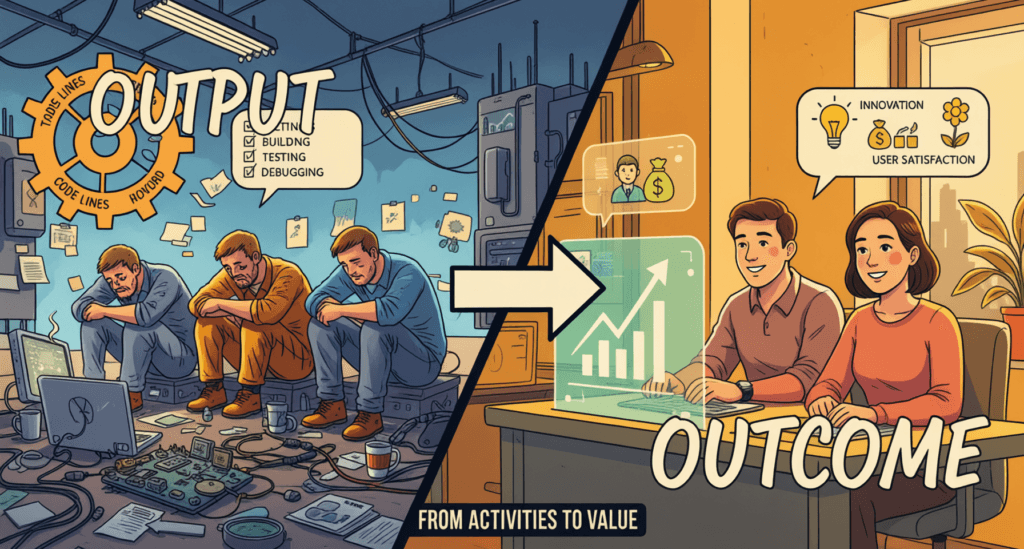
(A book review that reshaped how I view product strategy, delivery, and consulting)
Over the past few weeks, I interviewed more than 50 senior engineers and consultants.
Brilliant professionals — deeply technical, confident, experienced.

But when I asked one simple question —
“What was the outcome of your work?”
Most paused.
They could explain what they built, the systems they integrated, the sprints they completed…
But they struggled to describe what changed for the customer or the business.
That silence wasn’t about competence – it was about conditioning.
We’ve been trained to measure outputs, delivery, effort, completion – instead of outcomes – value, adoption, and impact.
That realization hit harder when I revisited Marty Cagan’s Inspired: How to Create Products Customers Love.
The book didn’t just redefine product management, it reframed how I think about success, not only in product teams but also in consulting engagements.
⚙️ The Core Idea – Build Less, Solve More
Cagan’s message is simple, almost obvious — and yet rarely practiced:
“The job of a product team is not to build more features. It’s to solve the right problems.”
He draws a sharp distinction between shipping fast and making an impact fast.
Between outputs (what you deliver) and outcomes (what value it creates).
Reading it as someone who’s spent years balancing consulting delivery and product strategy, it felt like a mirror.
Because consulting often gets trapped in the same paradox –
Delivering everything a client asks for, but not necessarily what truly moves the needle.
💡 Delivery Done Right, Outcome Gone Wrong
A few years ago, my team built a Coaching platform for a large enterprise client.
We delivered exactly what was asked — automation, analytics, integrations, even sleek dashboards.
The launch went perfectly.
But months later, adoption was almost negligible.
We’d built everything – except what the users truly needed.
That’s when I learned the hard way what Cagan meant when he said:
“It doesn’t matter how many features you deliver if none of them solve the customer’s real problem.”
We had optimized for delivery excellence, not strategic impact.
It was an output success, but an outcome failure.
🧭 From Product to Consulting – Why Outcome Thinking Wins
Inspired taught me that outcome thinking isn’t just a product philosophy – it’s a consulting advantage.
In consulting, clients often come to us with a list of features or requirements.
And it’s tempting to deliver exactly what’s asked.
But true partnership lies in discovering why they need it – and whether it’ll drive measurable change.
Outcome thinking helps bridge that gap.
Here’s how it transforms the consulting approach:
- From vendor to strategic partner.
When you talk in outcomes, clients see you as someone who understands their business, not just their backlog. - From delivery reports to value stories.
Replace “We shipped 10 features” with “We improved campaign turnaround by 35%.” - From project success to product success.
A consulting project that delivers on time is good; one that delivers lasting business impact is unforgettable. - From compliance to collaboration.
Outcome-driven consulting invites clients into a shared journey of discovery – not just delivery.
📊 Metrics That Reflect Product and Consulting Success
Here’s how I now frame conversations — whether with product teams or consulting clients:
| Dimension | Output Thinking | Outcome Thinking |
|---|---|---|
| Goal | Deliver the scope | Deliver business value |
| Focus | Activity and effort | Impact and results |
| Typical Metrics | Story points, release count, on-time delivery | Adoption, retention, efficiency gain, revenue lift |
| Narrative | “We met all milestones.” | “We increased campaign throughput by 40%.” |
| Feedback Loop | Ends at delivery | Continues through discovery and measurement |
In consulting, outcome thinking shifts the narrative from “we built it” to “we moved the needle.”
That’s the kind of language executives remember.
🌱 Building a Culture That Cares About Outcomes
Outcome orientation isn’t a process change – it’s a culture change.
Whether in product or consulting, it starts by asking:
- What’s the problem worth solving?
- What will success look like for the end user?
- How will we measure the real change created?
When teams internalize these questions, they stop chasing approvals and start chasing results.
They stop executing projects and start shaping strategy.
That’s what turns a consultant into a trusted advisor, and a product team into an innovation engine.
✨ Final Reflection — My Takeaway from Inspired
Reading Inspired didn’t teach me how to build better products – it taught me how to think better about the purpose behind every build.
It reminded me that:
- In product teams, outcomes build innovation.
- In consulting, outcomes build credibility.
Because at the end of the day, both worlds share the same truth –
Output creates motion. Outcome creates meaning.
So now, when my team proudly says,
“We delivered everything,”
I ask,
“Beautiful. But what changed for the customer?”
That one question – inspired by Inspired – has quietly become the compass for everything we do.
💭 What About You?
Have you ever celebrated a successful delivery only to realize it didn’t create much impact?
How do you ensure your teams – or your clients – stay outcome-focused, not output-driven?
🔗 If you build products, lead teams, or consult for clients, Inspired is a must-read.
It doesn’t just teach how to create great products – it teaches how to deliver lasting value.
More reflections like this at vinitks.com.